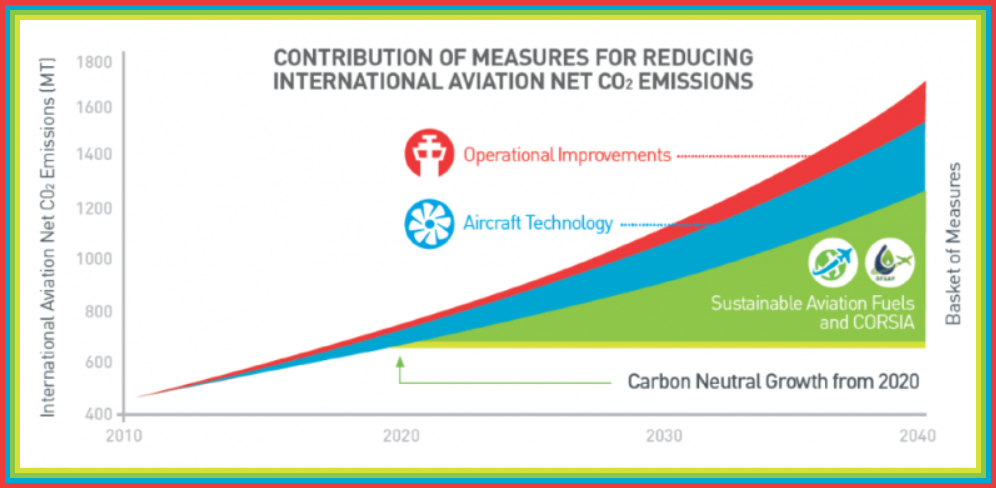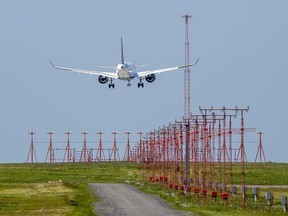CANADA AND CHINA on CORSIA—what’s real and why?


The global goal for reducing aviation’s carbon emissions can only be achieved by a multinational shared strategy with measurable results. It is not enough for individual government to declare that “we’ll be better”- such a commitment MUST HAVE SPECIFIC DATES, PRECISE QUANTIFICATION, AND CLEARLY ARTICULATED/RELIABLE CO REDUCTION TACTICS. The world’s aviation community has met many times to develop a coordinated strategy. After much debate, the INTERNATIONAL CIVIL AVIATION ORGANIZATION MEMBERS AGREED TO A CARBON OFFSETTING AND REDUCTION SCHEME FOR INTERNATIONAL AVIATION (CORSIA). The result is a convoluted “scheme” [such an apt name] to make aviation GREENER. As the above chart shows, CORSIA allows some countries more time to participate in CORSIA, which is only a measuring stick for decarbonization—NOT ANYTHING RESSEMBLING ENFORCEABLY CO GOALS.
In that context, the below two articles are most telling. First, two major Canadian aviation leaders call out their country for its lassitude in its CORSIA efforts. Specifically, the critics point out that people to our North for using its natural, technical, and experiential resources to be in the lead to manufacture and distribution of Sustainable Aviation Fuel. It can be expected that this self-admission of laggard pursuit of this critical green aviation enhancement will result in immediate Canuck Carbon Contributions

In stark contrast, the world’s #2 population issues proud proclamation that the People’s Republic of China is accelerating towards Aviation CO Reduction.
However, the PRC posited that its participation in CORSIA is deferred, as its larger neighbor (#1 India) and their totalitarian ally to the North, Russia have also have. This slower pace was intended to allow countries without the technical resources, economy, and wherewithal to meet the standards for the more sophisticated countries. REALLY???
After a meeting of the PRC Party Assembly, the leadership has issued edicts for short and long term decarbonization goals. Inscrutability is an historic characteristic or as a variation on Winston Churchill’s phrase:
“China is a riddle wrapped in a mystery inside an enigma.”
The established standards for the PRC’s green aviation goals are sufficiently vague enough for assertions that they were successes in 2025 and 2035 without any measurable, substantive, verifiable results.
[Though not perfect, the FAA’s record is progress-marked and transparent.]

The most blatant aviation environmental problem with the PRC is its lack of CORSIA participation. Why make such an empty boast?
A GUESS: the PRC has produced a commercial airliner, which not surprisingly its CAA has certificated. The C919s are being marketed to nations without strong balance sheets. Marketing these aircraft with the catch line “GREEN COMAC” CONCEPT is a great way to sell them {article about where the innards of these planes really come from}

‘Bizarre’ that Canada lagging on sustainable aviation: Airbus Canada CEO

The Canadian Press

The chief executive of Airbus Canada says the country possesses the key factors to
place it at the cutting edge of sustainable jet fuel innovation — making it “bizarre” that
Canada lags behind the United States and Europe.
An Air Canada Airbus A220-300 airliner from Toronto arrives at Halifax Stanfield
International Airport in Enfield, N.S. on Monday, June 28, 2021.
PHOTO BY ANDREW VAUGHAN /The Canadian Press
MONTREAL — The chief executive of Airbus Canada says the country possesses the key factors to place it at the cutting edge of sustainable jet fuel innovation — making it all the more “bizarre” that Canada lags behind the United States and Europe on this front.

Benoit Schultz, who heads the Canadian wing of the plane-making giant, says the country’s long history of resource development, renewable energy, agriculture and aircraft manufacturing leave it ideally placed to lead developments around sustainable aviation fuel.
However, CANADA HAS YET TO COMMERCIALLY PRODUCE A DROP OF THE STUFF — often derived from used cooking oils or organic waste — while the U.S. has embarked on an ambitious incentives program and the European Union has set a timeline for green fuel thresholds.

Deborah Flint, who heads the Greater Toronto Airports Authority, says the INDUSTRY FACES AN “EXISTENTIAL THREAT” IF IT DOES NOT WORK TO DECARBONIZE QUICKLY, given the current cost of sustainable fuel and the rising need to deploy it amid stricter government rules and a heating planet.
Production rates for sustainable aviation fuel amount to roughly one per cent of global demand for jet fuel, which costs about one-fourth the price as its greener alternative.
The aviation industry, which has set a goal of net-zero emissions by 2050, is calling for more international co-ordination to establish standards and fund improvements, such as those targetted by the federal government’s $350-million pledge to support aerospace decarbonization earlier this year.
This report by The Canadian Press was first published Oct. 16, 2023.
China Plans For Green Aviation Ecosystem By 2035
BYSU WU
The NEWLY-PUBLISHED OFFICIAL DOCUMENT WILL GUIDE THE DEVELOPMENT OF CHINA’S CIVIL AVIATION MANUFACTURING INDUSTRY for the next 12 years.
Sources: SCMP; China Daily

SUMMARY
- China releases its FIRST OFFICIAL POLICY guidance on green aviation manufacturing, including goals for sustainable fuels, electric aircraft, and hydrogen-powered technology.
- Setting the TARGET PERIOD AS 2035 aligns with China’s national development goals and aims to achieve world-class environmental performance for domestically-made large civil aircraft.
- While COMAC has advocated the “Green COMAC” concept, industry leaders like Boeing and Airbus have already made progress in green and sustainable development.
On Tuesday, China released its first official policy guidance document on green aviation manufacturing for the period up to 2035. The plan outlines both short-term goals by 2025 and long-term goals by 2035.
Immediate targets
The short-term goals {2 years} include all the current hot topics in the civil aviation manufacturing industry, including:
- Demonstrating sustainable aviation fuels (SAF) use on China-manufactured civil aircraft.
- Commercialization of electric general aviation aircraft.
- Pilot operations of electric vertical take-off and landing aircraft (eVTOL).
- Feasibility verification of key technologies for hydrogen-powered aircraft.
The long-term goals for 2035 are even more ambitious, with the most significant one being to ensure that domestically-produced large civil aircraft, such as the C919 and its successors like the C929 (previously CR929 before Russia’s withdrawal), achieve world-class environmental performance, and to establish new energy aircraft as the mainstream in development.

Photo: COMAC C919
The reason for setting the target period as 2035 is primarily because, at the 20th National Congress of the Communist Party of China held last year, two key milestones were established for China’s national development goals: 2035 and the mid-century of this century.

This guideline document was issued by the Ministry of Industry and Information Technology of China and bears joint signatures from three other relevant national regulatory authorities: the Civil Aviation Administration of China (CAAC), the Ministry of Finance, and the Ministry of Science and Technology.
It’s worth mentioning that the current minister of the Ministry of Industry and Information Technology, Jin Zhuanglong, was previously the head of China’s core civil aviation manufacturing company, Commercial Aircraft Corporation of China (COMAC).
Commitment across the industry
As early as September 2020, Chinese President Xi Jinping pledged to the world during the 75th United Nations General Assembly General Debate that China’s carbon emissions would peak before 2030 and achieve carbon neutrality by 2060.
Research shows that the civil aviation industry contributes to climate change caused by human activities by approximately 3.5%. Civil aviation manufacturing is a significant source of carbon emissions in the upstream and downstream of the civil aviation industry. Therefore, a sustainability guideline for civil aviation manufacturing like this is crucial.
International collaboration
As a core player in China’s civil aircraft manufacturing industry, COMAC HAS LONG ADVOCATED THE “GREEN COMAC” CONCEPT. As of now, COMAC has signed a series of agreements with Boeing concerning sustainable fuels and materials but has not conducted tests for electric or hydrogen-powered applications on their existing civil aircraft platforms.
Meanwhile, the two industry giants, BOEING and AIRBUS, have already accumulated several years of experience1 in green and sustainable development. Boeing initiated its ecoDemonstrator program in 2012, and since then, 11 aircraft have served as flying testbeds for the program. According to Boeing’s website, the latest ecoDemonstrator is a Boeing-owned 777-200ER that will test 19 projects that can make aviation safer and more sustainable.
Airbus unveiled its ZEROe program in 2020, and now it has 4 four conceptual aircraft designs. Airbus’s ambition is to bring to market the world’s first hydrogen-powered commercial aircraft by 2035.
It’s worth mentioning that Airbus’s former CTO, Paul Eremenko, established a startup company in the United States called Universal Hydrogen. This company is dedicated to developing hydrogen-powered commercial aircraft, and it has chosen the ATR-72-600 as its platform. It successfully completed its maiden flight in March of this year.

Sources: SCMP; China Daily